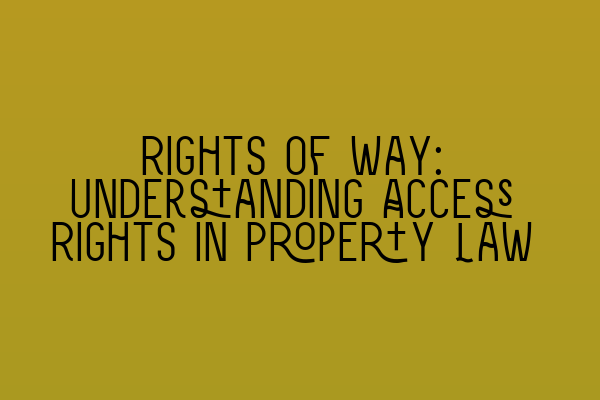Rights of Way: Understanding Access Rights in Property Law
In property law, access rights play a crucial role in determining the usage and enjoyment of land. Whether you are a property owner, a tenant, or someone with an interest in a piece of land, understanding rights of way is essential. This blog post aims to provide a comprehensive overview of rights of way, explaining their meaning, types, creation, and termination.
What are Rights of Way?
Rights of way, also known as easements, are legal rights that allow a person to pass across or use another person’s property. These rights are granted to ensure that individuals have access to their land or property, even if it is surrounded by other properties. They can be categorized into two main types: public rights of way and private rights of way.
Public Rights of Way
Public rights of way are paths or routes that are established by law and are open to the public for public use. They can be footpaths, bridleways, or byways, providing access for walkers, horse riders, and vehicles, respectively. These rights are recorded in official documents, such as definitive maps and statements, and are usually maintained by the local authorities.
Private Rights of Way
Private rights of way, on the other hand, are specific access rights granted to individuals or specific groups of people. They are usually created by a formal agreement, such as a deed or a contract, between the landowner and the beneficiary. Private rights of way can be used for various purposes, such as accessing a neighboring property, reaching a public road, or gaining access to facilities or amenities.
How Are Rights of Way Created?
Rights of way can be created in several ways, including express grant, implied grant, and prescription.
Express Grant: An express grant occurs when a landowner specifically grants a right of way to another person. This can be done through a written agreement, such as a deed or a contract, or by including the right of way in the property’s title deeds. It is essential for the grant to be clear and unambiguous to avoid any confusion or disputes in the future.
Implied Grant: An implied grant of a right of way can occur when it is necessary for the reasonable use and enjoyment of a property. This may arise in situations where a property is landlocked, meaning there is no direct access to a public road, and a right of way is required to reach the property. Implied grants can also be inferred from the historical use or local customs.
Prescription: Prescription is another way in which rights of way can be created. It involves the continuous and uninterrupted use of a particular access route for a specific period of time, usually 20 years or more. If the use is open, without permission, and without objection from the landowner, a right of way may be deemed to have been acquired through prescription. This is referred to as a prescriptive easement.
Termination of Rights of Way
Rights of way can be terminated in various ways, including by mutual agreement, abandonment, release, or by court order. It is important to note that the termination of a right of way requires proper legal procedures to ensure that all parties’ rights are protected.
Mutual Agreement: The parties involved in a right of way can choose to terminate it by mutual agreement. This usually requires a formal agreement, such as a deed of release, which outlines the terms and conditions of the termination.
Abandonment: If a right of way is not used for an extended period of time, it may be considered abandoned. However, the mere non-use of a right of way does not automatically result in its abandonment. Intent plays a crucial role in determining whether abandonment has occurred, and evidence of a clear intention to abandon the right of way is required.
Release: A release occurs when the owner of the right of way voluntarily gives up their entitlement to use the route. This can be done through a formal document, such as a deed of release, and it is important to ensure that all parties involved are in agreement.
Court Order: In some cases, a right of way may be terminated through a court order. This can happen if one party seeks to challenge or dispute the validity of the right of way, or if the court determines that the right of way is causing undue hardship or interference to the landowner.
Conclusion
Understanding rights of way is essential for anyone involved in property law. Whether you are a property owner, tenant, or interested party, knowing your rights and obligations regarding access is crucial. This blog post has provided a comprehensive overview of rights of way, including their meaning, types, creation, and termination. By understanding these key concepts, you can navigate property transactions and disputes with confidence.
For more information on property law and land law, check out our related articles:
– [SQE 1 Practice Exam Questions](https://fqps.co.uk/sqe/sqe1-preparation/mcq-practice-quiz)
– [SQE 1 Practice Mocks FLK1 FLK2](https://fqps.co.uk/sqe/sqe1-preparation/practice-mocks-quiz)
– [SQE 2 Preparation Courses](https://fqps.co.uk/sqe/sqe2-preparation)
– [SQE 1 Preparation Courses](https://fqps.co.uk/sqe/sqe1-preparation)
– [SRA SQE Exam Dates](https://fqps.co.uk/sqe/sqe1-sqe2-exam-dates)
At SQE Property Law & Land Law, our team of solicitors are dedicated to providing expert advice and assistance on all aspects of property law. Contact us today to discuss your specific requirements and ensure that your rights of way are protected.
